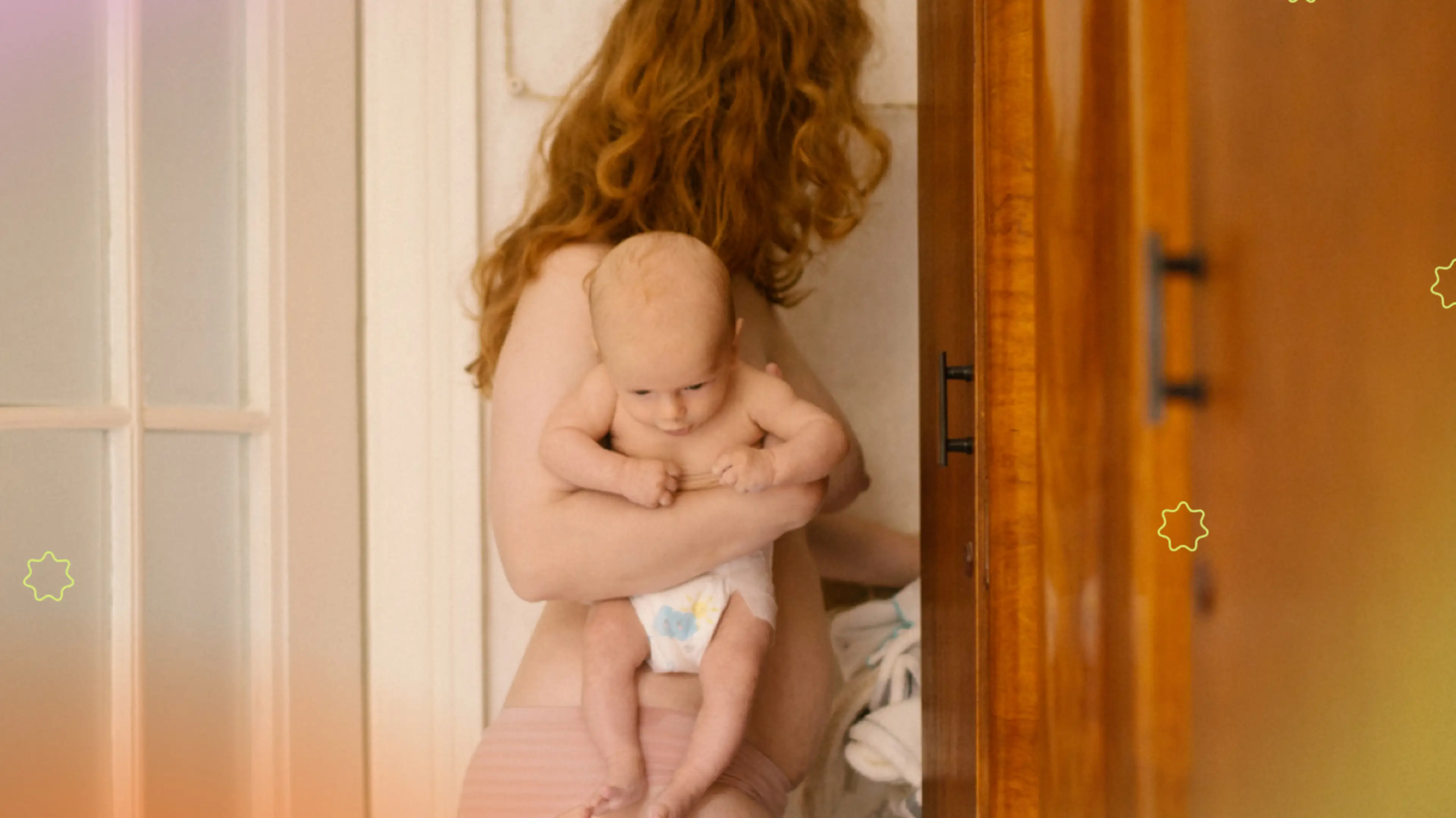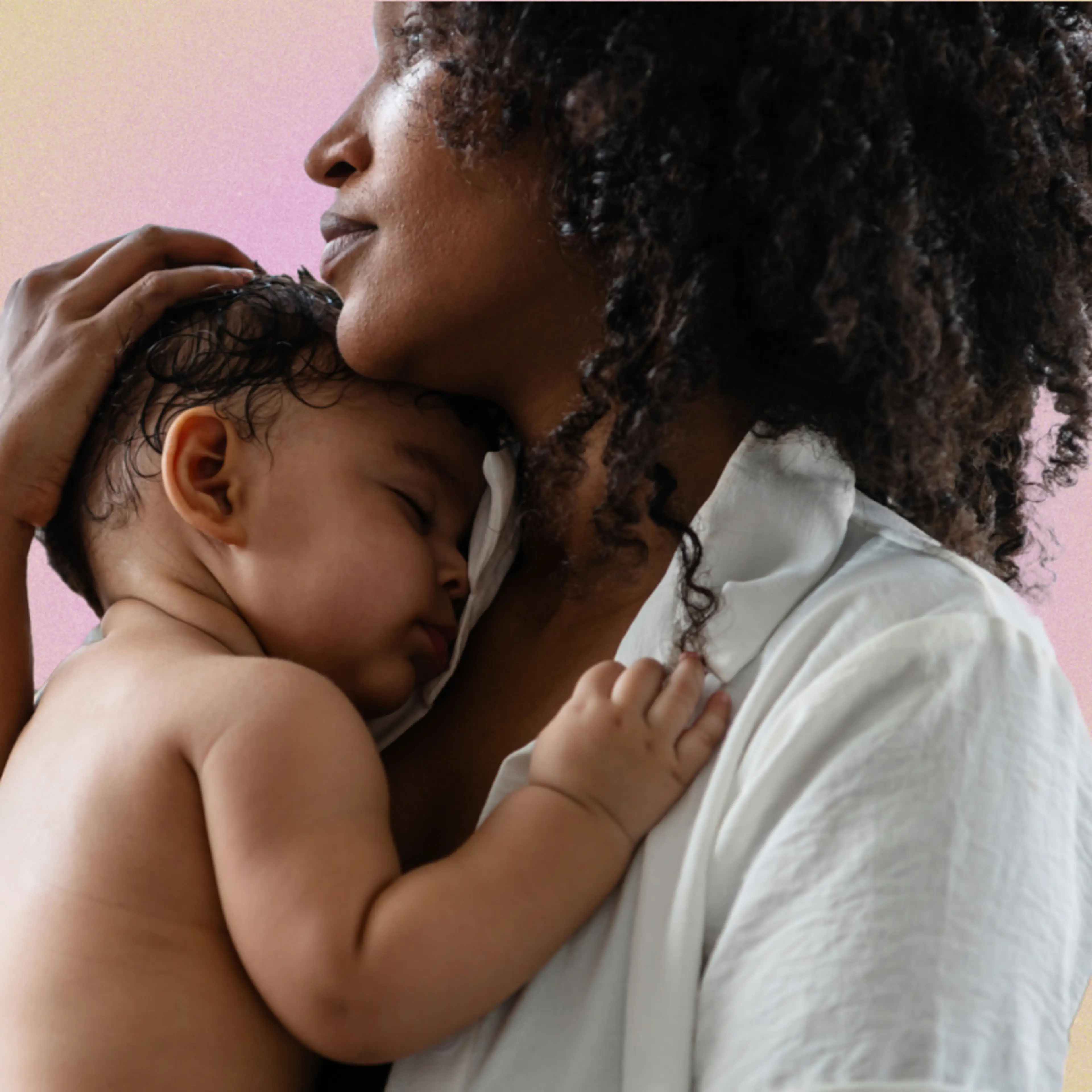TLDR: Postpartum OCD affects 3-7% of new moms and is the repetitive mental or physical responses to recurring intrusive thoughts, mental images, urges or impulses, usually centering around the new baby. Treatment for postpartum OCD can include therapy, medication, and meditation/mindfulness practices.
Postpartum OCD, or obsessive-compulsive disorder, is rarer than some other perinatal and postpartum mood and anxiety disorders, like postpartum depression and anxiety, but the awareness of it is increasing. It’s a specific form of obsessive-compulsive disorder, which is categorized by the World Health Organization as one of the top 10 most debilitating mental health disorders1 . Postpartum OCD affects 3-7% of new moms2 , but multiple obsessive-compulsive symptoms are more common in the postpartum period than at other times in your life. In fact, the first criteria of intrusive thoughts is experienced by nearly all new mothers, so some people might wonder if their thoughts aren’t just normal worries, but something more.
If you’re experiencing scary thoughts about yourself or your baby, it can feel like the weight of the world is pressing down on you. That’s why we sat down with Jenna Overbaugh, a licensed professional counselor and postpartum expert to break down postpartum OCD, guide you through seeking a diagnosis, receiving treatment, and coping with your new normal.
Overbaugh has been working with people who have OCD and anxiety for over a decade. When she experienced her own struggles with postpartum OCD,3 anxiety, depression, and medical gaslighting, she shifted her focus and her professional approach. Now, Overbaugh is a self-described cheerleader of compassion and empathy for mothers struggling with OCD, and she hopes to end the stigma around new moms needing mental health help.
What Is OCD?
Obsessive compulsive disorder4 is a complex and often misunderstood mental health condition. In its simplest terms, the disorder is categorized by recurring, unwanted thoughts, often called intrusive thoughts5 , mental images, urges, impulses, or even sensations that result in feelings of disgust, fear, or excessive guilt (obsessions). These obsessions will lead a person to perform some action to find relief or get away from the thought—these could include things like counting, cleaning, checking for bodily reactions, ruminating, or forcing yourself to try and find a distraction. Most people will repeat the action to try and get rid of or avoid the thoughts (compulsions).
“OCD does not just have to be about the fear of germs or needing everything to be clean and orderly. Although those manifestations do happen, it can be with anything. So the content of OCD is really only limited by one’s imagination,” says Overbaugh.
OCD has many subtypes6 : relationship, religious, sexual-orientation, contamination, and harm being a few. Any subtype of OCD ultimately comes back to the basics of obsessions and compulsions—postpartum OCD really just refers to OCD that occurs after one has a child. Perinatal OCD, or OCD during pregnancy, also exists.
How Is It Different from Anxiety?
Ask any parent and they’ll probably all say the same thing—worrying about accidentally hurting your child, doing something wrong, or being a “bad” parent is normal. While mothers with anxiety tend to overthink these worries, the difference is how one engages with the thoughts. Ultimately, the act of repetitive behaviors to find relief from the anxiety is what separates anxiety and OCD.
OCD thoughts are often irrational in nature and can become sticky, plaguing your mind. It’s also important to note that OCD thoughts are typically ego dystonic, meaning they’re not in line with your morals and values. A prime example of this is when the intrusive thoughts are sexual in nature. “A common obsession that’s very taboo and not often talked about, but very, very real and common for women and new dads as well, is unwanted sexually intrusive thoughts,” Overbaugh says. “These are unwanted—I can’t underscore that enough. These thoughts cause disgust, fear, and a lot of avoidance.”
Examples of postpartum OCD obsessions
Remember that these lists are not exhaustive; OCD thoughts can be about anything, but a few examples are:
Fear of breaking your baby's ankle when putting on their socks.
Fear of dropping your baby down the stairs.
Fear that you have looked at your child’s genitals for too long during diaper changes.
Fear of your baby becoming sick after a visit with relatives.
Fear of your child being taken while on a walk in the park.
Examples of postpartum OCD compulsions
Repeatedly checking to ensure you did not harm your baby.
Avoiding stairs or having someone else carry your baby up and down the stairs.
Mentally reviewing the events of the past to figure out if you did something “wrong.”
Excessively washing or sanitizing yourself and your child after visits.
Praying repeatedly that nothing will happen to your child.
How Is It Related to Other PMADs?
Perinatal and postpartum mood and anxiety disorders7 , or PMADs, is a term used to describe anxious, distressing, or excessive sadness and other feelings that occur during pregnancy (perinatal) and throughout the first year after pregnancy (postpartum). There are several mood disorders that can arise specifically during pregnancy and postpartum. Some of those conditions are more common than others, like the baby blues, perinatal anxiety and postpartum depression.
Postpartum OCD and postpartum depression
For women experiencing postpartum OCD, depression can present itself in two ways. One, a new or soon-to-be-mom can become anxious about negative thoughts, forcing herself to isolate and exacerbate the issue. This can sometimes lead to depression on top of OCD. On the other hand, if you’re depressed initially, it can lead to an uptick in negative thoughts. This can lead to increased obsessive tendencies. While it doesn’t always happen the same way, the answer to this question is ultimately yes, it is possible to be diagnosed with both depression and OCD at the same time.
Postpartum OCD and postpartum psychosis
Postpartum psychosis is also an extremely rare condition, affecting between 0.1and 2.6% of new mothers8 , but because the content of intrusive OCD and psychosis thoughts can sometimes be similar, it’s possible to be incorrectly diagnosed and subsequently receive the wrong treatment. For women seeking treatment or a diagnosis of postpartum OCD, it’s important to understand the differentiators between OCD and psychosis. With psychosis, women are curious about or act on their impulses to harm. Psychosis can also materialize as delusions and strongly held beliefs or hallucinations, both visual and auditory. For people with OCD, the thoughts are the opposite of what a person believes or wants, and they almost never act on their thoughts9 .
A quick note on anxiety disorders: Postpartum OCD may not present with another PMAD, but it can co-exist with different types of anxiety disorders. These include trichotillomania10 (hair pulling), excoriation11 (skin-picking), body dysmorphia12 , or even hoarding.
How To Get a Proper Diagnosis
If you or someone you love are displaying signs of postpartum OCD, you may wonder how to get a formal diagnosis. It’s understandable why people hesitate to ask for help. Beyond stigmas, you may also feel unsafe sharing the full content of your intrusive thoughts. Overbaugh’s number one tip for seeking treatment is to come prepared and be ready to advocate for yourself.
“Be very clear in how much it is that you’re struggling so that your doctor takes you seriously,” she says. “Also, be sure that you communicate that these are ego dystonic thoughts, that these are thoughts that you do not want to have, and that these are actually very characteristic of obsessive compulsive disorder.”
Depending on where you live, the technicalities may be different, but according to the International OCD Foundation, only a trained healthcare or mental health professional can diagnose OCD14 .
Therapists will look for three things:
You have obsessions.
You have compulsive rituals or behaviors.
Your obsessions and compulsions take time out of or greatly affect your daily life.
Choosing the Right Treatment for You
After you’ve received your diagnosis, the next step is treatment. While there are a variety of methods for addressing OCD, exposure and response prevention therapy15 is the gold standard. Depending on your schedule, budget, and willingness, you can explore what feels right for you—be sure to talk with your doctor or therapist if you aren’t sure where to begin or are feeling overwhelmed.
Exposure and Response Prevention (ERP) Therapy
ERP is a form of another common therapy type called cognitive behavioral therapy16 (CBT). ERP can help people with OCD, PTSD, and other phobias learn to identify and cope with their triggers. It works by gradually exposing a person to something that would provoke an obsession, but asks them to not act on their compulsions. In this technique, they are eventually able to sit with any discomfort they might be feeling, but they’re freed from the cycle of ritualistic behavior. In a nutshell, you get used to your anxiety, and you can get back to living your life.
Overbaugh recommends ERP for postpartum OCD, too: “ERP is tried and tested, and has the most trophies behind it when it comes to evidence-based OCD treatment. It is a gradual way of working with a person to approach their fears in a way that’s challenging but manageable, while reducing their safety behaviors or reducing their compulsions.”
Acceptance and commitment therapy
Acceptance and commitment therapy17 , or ACT, is another therapy that falls under the CBT umbrella and has many similarities to ERP. In this type of therapy, the patient is asked to engage in a concept called psychological flexibility18 —being in your present moment and experiencing whatever thoughts you may be having without actively trying to change or avoid them, and instead changing your behavior based on your decided-on goals and values. ACT may be beneficial for people who are struggling with ERP.
Medication and Selective Serotonin Reuptake Inhibitors (SSRIs)
Certain psychiatric medications can help control obsessive thoughts and compulsions. Antidepressants are usually the first choice for OCD19 , and though they are named antidepressants, it does not mean you are or have to be depressed to use them. These types of medications work by altering chemicals in the brain and can take several weeks or months to produce results. It’s not uncommon to have to try different medications, different doses, combinations of medication and other techniques.
If medication feels like a good choice for you, be sure to talk to your doctor about potential side effects. Ask if there is an increased risk of suicide, concerns if you are breastfeeding, or if there could be interactions with other medications you take.
Mindfulness & Meditation
We want to preface this section by saying that there is no way to meditate your OCD away. Instead, think of mediation as a tool in your wellness kit—like a companion to other therapies. Meditation and mindfulness with OCD20 means you may observe and accept unwanted thoughts without judging or attaching meaning to them. Meditation also has many research-backed benefits for OCD sufferers, like lowering stress21 , decreasing cortisol22 , and boosting dopamine23 .
Does Postpartum OCD Ever Go Away?
This is probably the question most people with OCD will ask when they set out on their journey to overcome it. There’s no clear yes or no, and it’s true that OCD may not ever fully go away. It could be something you live with forever, but you won’t always meet diagnostic criteria for it.
That’s actually good news, because it means that OCD can wax and wane. Anxiety is a natural part of life, and something could trigger you weeks, months or years down the road. Once you have a diagnosis and begin therapy—or whatever treatment you choose—you’ll hopefully feel better prepared and able to move through any hard spot that comes your way.
“I know plenty of people—including myself, who used to meet diagnostic criteria for OCD—who would no longer meet diagnostic criteria for OCD,” Overbaugh says. “It doesn’t mean that I still don’t have triggers every once in a while…We’re all gonna get anxious every once in a while and we’re gonna sit with discomfort and we’re gonna have to try to challenge ourselves.”
Conclusion
If you’re currently experiencing unwanted intrusive thoughts, the most important thing to remember is that you are not alone. Overbaugh recommends educating yourself by looking at online resources (like NOCD24 for instance), finding OCD communities, and of course, by talking to your doctor. You can also check out the All the Hard Things25 podcast hosted by Overbaugh, which explores OCD and mental wellness.
New mothers are already up against so much. From navigating changes in your schedule to hormonal fluctuations and lack of sleep. If you, or someone you know, are experiencing obsessions and compulsive behavior, know that you are not a bad parent. Thoughts can feel consuming and real in the moment, but you can learn to manage them and find relief.











